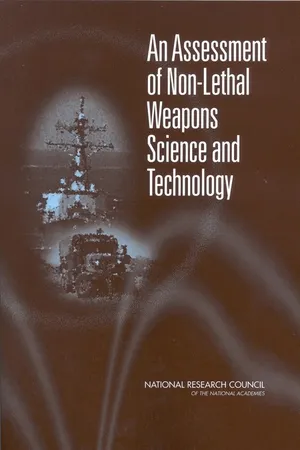
- English
- ePUB (mobile friendly)
- Available on iOS & Android
About this book
Non-lethal weapons (NLWs) are designed to minimize fatalities and other undesired collateral damage when used. Events of the last few years including the attack on the USS Cole have raised ideas about the role NLWs can play in enhancing support to naval forces. In particular to what extent and in what areas should Department of the Navy (DoN) -sponsored science and technology (S&T) provide a research base for developing NLW capabilities? To assist with this question and to evaluate the current NLWs program, the Joint Non-Lethal Weapons Directorate (JNLWD) and the Office of Naval Research (ONR) requested the National Research Council perform an assessment of NLWs science and technology. The report presents the results of that assessment. It discusses promising NLW S&T areas, development accomplishments and concerns about NLW, and series of recommendations about future NLW development and application.
Frequently asked questions
- Essential is ideal for learners and professionals who enjoy exploring a wide range of subjects. Access the Essential Library with 800,000+ trusted titles and best-sellers across business, personal growth, and the humanities. Includes unlimited reading time and Standard Read Aloud voice.
- Complete: Perfect for advanced learners and researchers needing full, unrestricted access. Unlock 1.4M+ books across hundreds of subjects, including academic and specialized titles. The Complete Plan also includes advanced features like Premium Read Aloud and Research Assistant.
Please note we cannot support devices running on iOS 13 and Android 7 or earlier. Learn more about using the app.
Information
Table of contents
- COVER PAGE
- THE NATIONAL ACADEMIES
- COMMITTEE FOR AN ASSESSMENT OF NON-LETHAL WEAPONS SCIENCE AND TECHNOLOGY
- NAVAL STUDIES BOARD
- Preface
- Acknowledgment of Reviewers
- Contents
- Prologue
- Executive Summary
- 1 Introduction
- 2 The Current Status of Non-Lethal Weapons
- 3 Principal Findings
- 4 Conclusions
- 5 Recommendations
- Appendixes